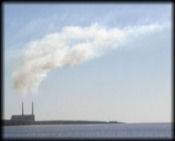Lingan Plant Province's Top Polluter
By Tanya Collier MacDonald
Cape Breton Post
Wed., Sept. 24, 2003
View further analysis (with comparison tables) at www.pollutionwatch.org
The Lingan Generating Station spews nearly half of this province's total air pollution making it the dirtiest in Nova Scotia, reports an environmental watchdog.

"It's time it cleaned up its act," said Rick Smith, executive director of Environmental Defence Canada, which partnered with the Canadian Environmental Law Association and Canadian Institute for Environmental Law and Policy to develop a list of the top 10 air polluters in Nova Scotia.
The list was released Tuesday.
"It's putting hydrochloric acid, sulphuric acid, hexachlorobenzene and mercury up its stack every day," said Smith.
The chemicals are both harmful to human health and the environment with some known to cause breathing problems and others identified as carcinogens.
What's needed are generating stations fuelled by natural gas as opposed to coal and oil, said Smith.
"That would make an immediate difference," he said. "And it needs to happen quickly in Nova Scotia."
Other Cape Breton facilities listed as top air polluters are the Point Tupper Generating Station in third spot, the Point Aconi Generating Station ranking fourth and the Stora Enso Port Hawkesbury Ltd. as the ninth top polluter in the province.
In total, Cape Breton facilities are responsible for nearly 65 per cent of Nova Scotia's air pollution, reported the three groups collectively known as PollutionWatch.
Nova Scotia Power Inc. has four of its power plants on the top 10 list which makes it responsible for nearly 84 per cent of the province's air pollution, he continued.
"Over the last seven years
across Canada, pollution has
increased by 20 per cent," said
Smith. "These big polluters in
Nova Scotia have old technology.
Even if power consumption
remains at current levels,
there are ways to reduce air
pollution and those steps
aren't being taken," he said.
He's hoping increased public
awareness will force companies
to improve their operations.
"There's a real power to
drag these more delinquent
industries into the light of day
and comparing them to their
competitors, in some cases,
who are doing a much better
job," said Smith. "Canadians
are willing to reward good
corporate citizens."
NSP applauds the efforts of the environmental watchdog.
"We see that PollutionWatch is correctly raising the level of concern and raising the need for action," said Margaret Murphy, spokesperson for NSP. "They want to make sure that this issue doesn't drop below the radar screen and it continues to get peoples' attention."
Murphy said the power
company is committed to
being cleaner and that
includes efforts at the Lingan
Generating Station - its
biggest facility at a capacity of
600 megawatts a day and
providing about 25 per cent of
Nova Scotia's power.
"We're introducing a new
gas-fired turbine we're
commissioning this fall here in
Halifax," said Murphy.
"Increasingly, we're looking
hard at our older power plants
in our fleet and asking what
new technology additions may
be appropriate, might those be
scrubbers? We know we need
to reduce air emissions by
targets set out (by government),"
said Murphy.
But coal-fired plants are
likely to continue operating
for decades, she added.
A multi-faceted approach with the
use of lower sulphur coal,
clean-coal technologies,
natural gas and more renewables
is a more likely direction, said
Murphy.
As well as making industry
more responsible, Pollution
Watch is also calling on
government to enact regulations
to reduce and eliminate pollutants
released into the air by
industrial facilities.
The Nova Scotia government
has committed to following
an energy strategy to
reduce mercury emissions by
30 per cent below their 1995
levels by 2005, and a further
reduction of 60-90 per cent by
2010. But, sulphuric acid continues
to be emitted into the
air - a concern not addressed
in the provincial government's
current energy strategy.
Pollution Watch tracks pollution
across Canada on its
Web site, www.pollutionwatch.org,
based on data collected by
Environment Canada through
the National Pollutant
Release Inventory.
tcmacdonald@cbpost.com
|